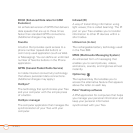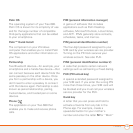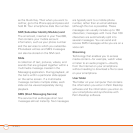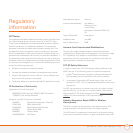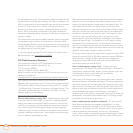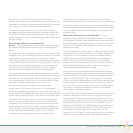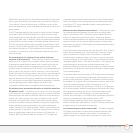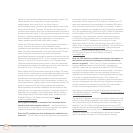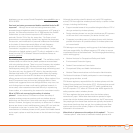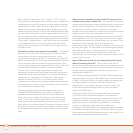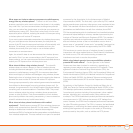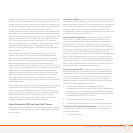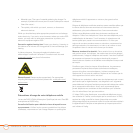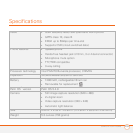
REGULATORY INFORMATION
252
likened to a thin pancake centered around the antenna system. The
individual pattern for a single array of sector antennas is
wedge-shaped, like a piece of pie. As with all forms of
electromagnetic energy, the power decreases rapidly as one moves
away from the antenna. Therefore, RF exposure on the ground is
much less than exposure very close tothe antenna and in the path of
the transmitted radio signal. In fact, ground-level exposure from such
antennas is typically thousands of times less than the exposure levels
recommended as safe by expert organizations. So exposure to
nearby residents would be well within safety margins.
Cellular and PCS base stations in the United States are required to
comply with limits for exposure recommended by expert
organizations and endorsed by government agencies responsible for
health and safety. Measurements made near cellular and PCS base
station antennas mounted on towers have confirmed that
ground-level exposures are typically thousands of times less than the
exposure limits adopted by the FCC. In fact, in order to be exposed to
levels at or near the FCC limits for cellular or PCS frequencies an
individual would essentially have to remain in the main transmitted
radio signal (at the height of the antenna) and within a few feet from
the antenna. This is, of course, very unlikely to occur.
When cellular and PCS antennas are mounted on rooftops, RF levels
on that roof or on others near by would probably be greater than those
typically encountered on the ground. However, exposure levels
approaching or exceeding safety guidelines should be encountered
only very close to or directly in front of the antennas. In addition, for
sector-type antennas, typically used for such rooftop base stations, RF
levels to the side and in back of these antennas are insignificant.
General guidelines on antenna installations and circumstances that
might give rise to a concern about a facility's conformance with FCC
regulations can be found in A Local Government Official's Guide to
Transmitting Antenna RF Emission Safety: Rules, Procedures, and
Practical Guidance. This Guide can be accessed at: http://
www.fcc.gov/oet/rfsafety.
Who regulates exposure to radiation from microwave ovens,
television sets and computer monitors? The Food and Drug
Administration is responsible for protecting the public from harmful
radiation emissions from these consumer products.
Does the FCC routinely monitor radiofrequency radiation from
antennas? The FCC does not have the resources or the personnel
to routinely monitor the emissions for all the thousands of
transmitters that are subject to FCC jurisdiction. However, the FCC
does have measurement instrumentation for evaluating RF levels in
areas that may be accessible to the public or to workers. If there is
evidence for potential non-compliance with FCC exposure guidelines
for a FCC-regulated facility, staff from the FCC's Office of Engineering
and Technology or the FCC Enforcement Bureau can conduct an
investigation, and, if appropriate, perform actual measurements.
Circumstances that could give rise to a concern about a facility's
conformance with FCC regulations can be found in A Local
Government Official's Guide to Transmitting Antenna RF Emission
Safety: Rules, Procedures, and Practical Guidance. This Guide can be
accessed at: http://www.fcc.gov/oet/rfsafety
. Potential exposure
problems should be brought to the FCC's attention by contacting the
FCC RF Safety Program at: 202-418-2464 or by email:
rfsafety@fcc.gov
.
Does the FCC maintain a database that includes information on
the location and technical parameters of all the transmitting
towers it regulates? Each of the FCC Bureaus maintains its own
licensing database system for the service(s) it regulates (e.g.,
television, cellular service, satellite earth stations.) The FCC issues
two types of licenses: site specific and market based. In the case of
site specific licensed facilities, technical operating information is
collected from the licensee as part of the licensing process. However,
in the case of market based licensing (e.g., PCS, cellular), the
licensee is granted the authority to operate a radio communications
system in a geographic area using as many facilities as are required,
and the licensee is not required to provide the FCC with specific
location and operating parameters of these facilities.
Information on site specific licensed facilities can be found in the
“General Menu Reports” (GenMen) at
http://gullfoss2.fcc.gov/cgi-bin/
ws.exe/genmen/index.hts.
The various FCC Bureaus also publish on at least a weekly basis, bulk
extracts of their licensing databases. Each licensing database has its
own unique file structure. These extracts consist of multiple, very
large files. The FCC's Office of Engineering and Technology (OET)
maintains an index to these databases at http://www.fcc.gov/oet/info/
database/fadb.html. Entry points into the various databases include
frequency, state/county, latitude/longitude, call-sign and licensee
name. For further information on the Commission's existing



